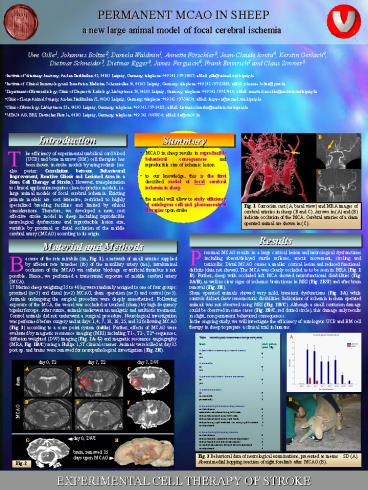Folie 1 - PowerPoint PPT Presentation
Title:
Folie 1
Description:
... absent/delayed startle reflexes, atactic movement, circling and torticollis. ... 3. paretic right limbs / atactic movement. no 0. yes 1. 4. circlic movement ... – PowerPoint PPT presentation
Number of Views:74
Avg rating:3.0/5.0
Title: Folie 1
1
a new large animal model of focal cerebral
ischemia
PERMANENT MCAO IN SHEEP
Uwe Gille1, Johannes Boltze2, Daniela Waldmin1,
Annette Förschler3, Jean-Claude Ionita4, Kerstin
Gerlach4, Dietmar Schneider5, Dietmar Egger6,
James Ferguson4, Frank Emmrich2 and Claus Zimmer3
1Institute of
Veterinary Anatomy, An den Tierkliniken 43, 04103
Leipzig , Germany telephone 49 341 / 97-38057
eMail gille_at_vetmed.uni-leipzig.de 2Institute of
Clinical Immunology and Transfusion Medicine,
Johannisallee 30, 04103 Leipzig , Germany
telephone 49 341 / 97-25820 eMail
johannes.boltze_at_gmx.de 3Department of
Neuroradiology, Clinic of Diagnostic Radiology,
Liebigstrasse 20, 04103 Leipzig , Germany
telephone 49 341 / 97-17410 eMail
annette.foerschler_at_medizin.uni-leipzig.de 4Clinic
of Large Animal Surgery, An den Tierkliniken 21,
04103 Leipzig , Germany telephone 49 341 /
97-38250 eMail ferguson_at_vetmed.uni-leipzig.de 5C
linic of Neurology, Liebigstrasse 22a, 04103
Leipzig , Germany telephone 49 341 / 97-24221
eMail dietmar.schneider_at_medizin.uni-leipzig.de 6V
ITA34 AG, BBZ, Deutscher Platz 5a, 04103 Leipzig
, Germany telephone 49 341 / 48792-0 eMail
de_at_vita34.de
A
B
Introduction
Summary
T
he efficiency of experimental umbilical cord
blood (UCB) and bone marrow (BM) cell therapies
has been shown in stroke models by using
rodents (see
- MCAO in sheep results in reproducible behavioral
consequences and reproducible size of ischemic
lesion - to our knowledge, this is the first described
model of focal cerebral ischemia in sheep - the model will allow to study efficiency of
autologous cell and pharmaceutical therapies upon
stroke
also poster Correlation between Behavioural
Improvement, Reactive Gliosis and Lesioned Area
in a Stem Cell Therapy of Stroke). However,
transplantation to clinical application requires
close-to-practice models, i.e. large animal
models of focal cerebral ischemia. Existing
primate models are cost intensive, restricted to
highly specialized breeding facilities and
limited by ethical considerations. Therefore, we
developed a new, cost effective stroke model in
sheep including reproducible neurological
dysfunctions and reproducible lesion size,
variable by proximal or distal occlusion of the
middle cerebral artery (MCAO) according to its
origin.
C
Fig. 1 Corrosion cast (A, basal view) and MRA
images of cerebral arteries in sheep (B and C).
Arrows in (A) and (B) indicate occlusion of the
MCA. Cerebral arteries of a sham operated animal
are shown in (C).
Results
Material and Methods
P
roximal MCAO results in a large cortical lesion
and neurological dysfunctions including
absent/delayed startle reflexes, atactic
movement, circling and torticollis. Distal MCAO
causes a smaller cortical lesion and reduced
functional
B
ecause of the rete mirabile (rm, Fig. 1), a
network of small arteries supplied by afferent
rete branches (rb) of the maxillary artery (ma),
intraluminal occlusion of the MCAO via
catheter blockage or artificial thrombus is not
deficits (data not shown). The MCA was clearly
occluded as to be seen in MRA (Fig. 1 B).
Further, sheep with occluded left MCA showed
neurofunctional disabilities (Fig. 3A/B), as well
as clear signs of ischemic brain tissue in MRI
(Fig. 2E/F) and after brain removal (Fig.
2H). Sham operated animals showed very mild,
transient dysfunctions (Fig. 3A) while controls
did not show sensomotoric disabilities.
Indications of ischemia in sham operated animals
was not observed using MRI (Fig. 2B/C). Although
a small contusion damage could be observed in
some cases (Fig. 2B/C, red dotted circle), this
damage only results in slight, non permanent
behavioral consequences. In the ongoing study, we
will investigate the efficiency of autologous UCB
and BM cell therapy in sheep to prepare a
clinical trial in humans.
possible. Hence, we performed a transcranial
exposure of middle cerebral artery (MCA). 17
Merino sheep weighting 35 to 48 kg were randomly
assigned to one of four groups proximal (n5)
and distal (n2) MCAO, sham operation (n5) and
control (n5). Animals undergoing the surgical
procedure were deeply anaesthetised. Following
exposure of the MCA, the vessel was occluded or
touched (sham) by high frequency bipolar forceps.
After suture, animals underwent an analgetic and
antibiotic treatment. Control animals did not
underwent a surgical procedure. Neurological
investigation was performed before surgery and at
days 1, 4, 7, 10, 16, 25, and 32 following MCAO
(Fig. 3) according to a score point system
(table). Further, effects of MCAO were evaluated
by magnetic resonance imaging (MRI) including
T1-, T2-, T2-sequences, diffusion weighted (DW)
imaging (Fig. 2A-G) and magnetic resonance
angiography (MRA, Fig. 1B/C) using a Philips 1,5T
clinical scanner. Animals were killed at day 35
post op. and brains were removed for
neuropathological investigation (Fig. 2H).
A
Table neurological examination score point
system Item
score points (max.
14) 1. food debris remaining in mouth corner no
0 yes 1 2.
torticollis no 0 yes
1 3. paretic right limbs / atactic
movement no 0 yes
1 4. circlic
movement no 0 occasionally
1 permanently
2 5. disturbed right hemistanding
reaction no disturbance
0 immediate adjustment using left limbs
1 delayed adjustment using left limbs
2 delayed adjustment using
right limbs 3 delayed using
right hindlimb / no using right forelimb
4 no adjustment 5 6.
disturbed right hopping reaction no disturbance
0 delayed medial, immediate
lateral adjustment 1 delayed
medial and lateral adjustment
2 no medial adjustment, delayed lateral
adjustment 3 no adjustment
4
B
Fig. 3 Behavioral data of neurological
examinations, presented as means SD (A). Absent
medial hopping reaction of right forelimb after
MCAO (B).
Fig. 2
EXPERIMENTAL CELL THERAPY OF STROKE































